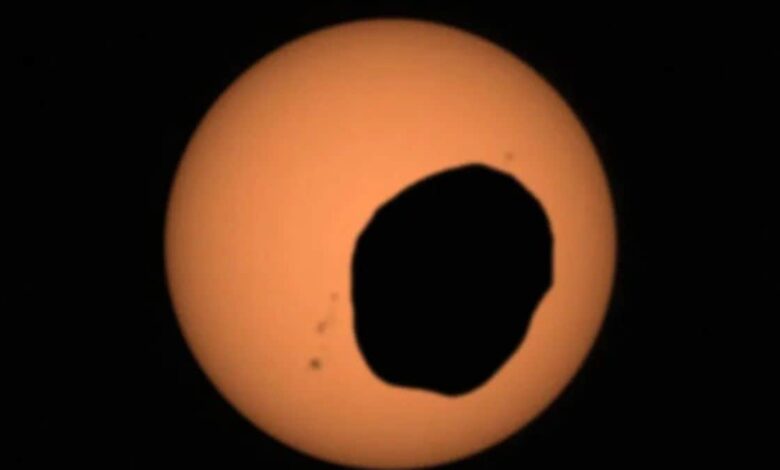NASA’s Perseverance Rover observes Google Eye Eclipse on Mars

NASA’s Perseverance rover, based in Mars’ Jezero Crater, recently observed a remarkable celestial event as the moon Phobos drifted in front of the Sun. The moment, captured on September 30, provided a rare glimpse into the Martian sky, where the eclipse’s unique ‘googly eye’ effect unfolded in front of the rover’s Mastcam-Z camera. The video, released by NASA, illustrates the interplay of the Martian moon’s orbits and provides valuable information about the trajectory of Phobos and its gradual shift toward Mars.
Unexpected solar eclipse creates ‘Googly Eye’ view on Mars
Perseverance, which has been observing the Martian surface and sky since 2021, recorded the silhouette of Phobos moving rapidly along the solar wall from Mars’ western Jezero crater. Phobos, the largest of The two moons of Marscreated a distinct visual ‘googly eye’ effect as it partially blocked sunlight, a phenomenon not normally visible from Earth. The eclipse, captured on the 1285th sol (Martian day) of the mission, highlights Phobos’ fast orbit, which takes just 7.6 hours to complete a full circle around Mars. Because of its close orbit, Phobos regularly crosses the Martian sky, allowing for short transits that last only about 30 seconds each.
Phobos’ eerie path and future on Mars
Phobos, named by astronomer Asaph Hall in 1877 after the Greek deity associated with fear, measures about 17 miles (27 kilometers) at its widest. Unlike Earth’s larger moon, Phobos appears much smaller in the Martian sky. Its orbit brings it closer to Mars over time, which scientists say will ultimately cause Phobos to collide with the Martian surface within the next 50 million years. Previous occultations of Phobos, also captured by other Mars rovers such as Curiosity and Opportunity, continue to provide essential data for understanding Mars’ moons and their changing orbits.
Perseverance’s mission and future exploration of Mars
As part of NASA’s Mars 2020 mission, Perseverance is focused on exploring the geology and astrobiology of Mars. The mission, managed by NASA’s Jet Propulsion Laboratory (JPL), is the first to collect samples of Martian surface material, which are intended to be retrieved in future joint missions with the European Space Agency (ESA). Perseverance’s Mastcam-Z, developed with support from Arizona State University, Malin Space Science Systems and the Niels Bohr Institute, plays a critical role in collecting high-resolution imagery to support geological studies. This mission aligns with NASA’s broader goal to prepare for human exploration of Mars, beginning with the Artemis missions to the moon.




